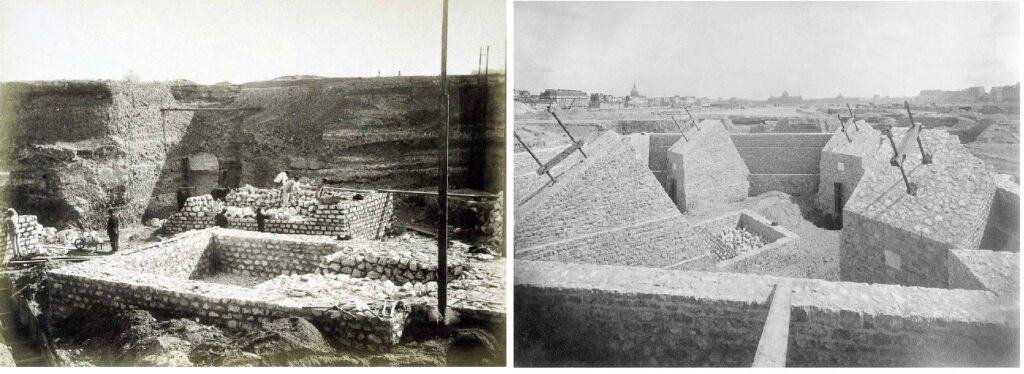
The blog of Alvaro Boiero
"Live as if you were going to die tomorrow. Learn as if you were going to live forever" Mahatma Gandhi

The blog of Alvaro Boiero
geo
"Live as if you were going to die tomorrow. Learn as if you were going to live forever" Mahatma Gandhi
Foundations in civil engineering
“Any structure is no stronger than its connections." Although it is usual for this statement to invoke images of the connections between individual structural members, it also applies to those between the superstructure and the ground that supports it. Basically, this connection is the foundation. Even the ancient builders knew that the most carefully designed structures could fail if they were not supported by adequate foundations (Coduto, 2001).
Content
What are foundations?
Let's start with a seemingly simple question, but one that is often difficult to answer accurately. As mentioned above, foundations are the connections between what is known as superstructure and the ground that supports it. But this connection has a particularity: the members it connects (the superstructure and the ground) may have very different stiffnesses. That is why foundations must be designed in such a way that the maximum pressure transmitted from the superstructure to the ground does not cause excessive deformation or rupture of the supporting soil (Taylor, 1948).
Loads from the superstructure are transmitted by columns, by load-bearing walls, or by other load-bearing members, to the foundations. In some cases, the foundation material is a very strong soil, so that, according to experience, no major foundation problems are usually expected. In other cases, the material immediately beneath the structure may be of such poor quality that loads from the superstructure must be transmitted by piles to deeper, higher strength strata.
The klepsydra analogy can be useful to better understand the superstructure-foundations interaction (Gutiérrez, 2016). The Structural Engineer responsible for designing the structure, concentrates the loads acting on the floor slabs to the beams, and from the beams to the columns or supporting walls, until they reach the foundations in the form of concentrated loads. From there, the Geotechnical Engineer, in an inverse process so that the concentrated loads do not generate ground failure, "expands" the point loads. He must look for foundation solutions by widening their surface, in the case of shallow foundations, and when they are deep foundations, try to bring the concentrated loads directly to the resistant soil strata or to achieve a sufficiently large contact area to dissipate the frictional stresses with the soil it crosses.

Figure 1 Analogy of a klepsydra with the methodologies used by structural engineers and geotechnical engineers to deal with structural loads (Source: Gutiérrez, 2016. http://www.construccionenacero.com/comment/236).
An important factor to take into account is that foundations must be designed and constructed in such a way as to ensure the stability of the superstructure throughout its useful life. Accordingly, it is evident that they must be designed taking into consideration the most unfavorable conditions expected, which must be properly identified by the Geotechnical Engineer at the time of the soil study for the project.
Another factor to take into account are loads to be transmitted by the superstructure: what type of loads (axial, lateral, moments) will they be? What is the estimated magnitude of these loads? What design criteria will be used? We will prepare another post related to this aspect. However, it is something that should be considered from the beginning as a fundamental aspect for the design.
Considering what has been mentioned so far, we are then able to answer the question formulated in the title of the section: what foundations are? Well, we can answer this question by stating that foundations are the members that connect the superstructure with the ground, and whose primary function is to transmit the loads to the ground, ensuring that: 1) the ground does not rupture; and 2) excessive deformations of the ground are not generated; so that the functionality of the superstructure is not affected during the useful life of the superstructure.
Origins of modern Foundation Engineering
Although builders have recognized the importance of firm foundations for countless generations, and the history of foundation construction spans thousands of years, the discipline of Foundation Engineering as we know it today did not begin its development until the late 19th Century (Coduto, 2001). In many ancient (and not so ancient, it must be said) constructions, foundation designs were based solely on previous experience, intuition, and common sense. Through trial and error, builders developed rules for foundation sizing and construction.
One of the first signs that engineers began to investigate the behavior of foundations and to develop more rational design methodologies, not based solely on rules of thumb, appears around 1873, when the architect Frederick Baumann published a work entitled The Art of Preparing Foundations, with a Particular Illustration of the "Method of Isolated Piers" as Followed in Chicago (see Figure 2). In this paper, soil is recognized as a compressible material, and classifies foundation soils as solid soils, compressible soils, and semi-fluid soils. It also proposes that the foundation area should be proportional to the applied load, and that this load should not be eccentric. The document also includes allowable contact pressure values for Chicago soils, and specifies tolerances for total and differential settlements.

Figure 2 Cover of document published by F. Baumann in 1873 (Source: https://books.google.co.ve/books?id=9uEtnQEACAAJ&printsec=frontcover&hl=es&source=gbs_ge_summary_r&cad=0#v=twopage&q&f=true).
Another example of the rationalization process of foundation design are the masonry bearing walls built in New York (USA) during the 19th Century. According to Powell (1884), masonry bearing walls built on compacted gravel should be supported by spread footings with a width equal to 1.5 times the width of the wall; in the case of walls installed on sand or hard clay, the width of the foundation should be equal to 3 times the width of the wall.
A particular case that illustrates the application of new ideas in the design of foundations, in order to ensure the long-term functionality of the structure, is that of the Eiffel Tower, located in Paris, France (Coduto, 2001). This tower, which is one of the most visited monuments in the world today, was built for the Paris Universal Exposition of 1889, and its designer and builder, Gustave Eiffel, was fully aware of the importance of foundations. The Eiffel Tower is located adjacent to the Seine River, on a difficult ground that includes uncontrolled backfills and soft, loose alluvial soils. Eiffel carried out a complete exploration of the subsoil, using 200 mm diameter pipes filled with compressed air. The air prevented water from entering the tube, which made it possible to recover high quality samples. Based on the performed exploration, Eiffel built the foundations of the two legs furthest from the Siena in good quality soil, above the water table; while the foundations of the other two legs, adjacent to the Siena, required excavating about 12 m below the ground surface (about 6 m below the water table) to be supported on firm ground. As a result of the importance Gustave Eiffel placed on ground exploration and foundation design, the Eiffel Tower has been in operation for more than 120 years without significant differential settlement.


Foundation Engineering began to develop more rapidly around the 1920s, as a result of the impetus given by the appearance of Karl Terzaghi's pioneering work, Erdbaumechanick auf Bodenphysikalischer Grundlage, in 1925. This development had the major impact of providing a better theoretical basis for foundation design, from which new construction methods were improved and developed. Thus, it is now possible to construct foundations in places where it was considered impossible or impractical to do so under the old practices.
Classification of foundations
Foundations, as already mentioned, are the elements that connect the superstructure to the ground. These elements can be built with concrete, steel, wood, or even other elements (Coduto, 2001).
These elements can be divided into two categories (Peck et al, 1953): shallow foundations and deep foundations. Shallw foundations transmit loads to superficial ground-layers, relatively close to the surface (typically, up to 2 m to 2.5 m deep, although some shallow foundations of industrial equipment may be supported at depths greater than 3.5 m); while Deep foundations transmit loads to deeper resistant strata. Figure 5 shows the classification of shallow and deep foundations.

Figure 5 Classification of foundations.


Some authors, such as Terzaghi (1943), differentiate between shallow and deep foundations by considering the embedment depth of the foundation Df and the minimum width of the foundation B. Thus, shallow foundations are those that present a ratio Df/B ≤ 1, while deep foundations present a ratio Df/B > 1. However, in my opinión, the conceptual difference between shallow and deep foundations is obvious, so I do not think it is appropriate to consider this type of criteria to differentiate them.
Uncertainties in Foundation Engineering
On one occasion, Dr. José Grases Galofre, a prominent Venezuelan engineer and professor, spoke to me about the definition of Structural Engineering: "Structural Engineering is the art and science of modeling materials that we do not fully understand, with shapes that we cannot analyze precisely, subjected to loads that cannot be adequately predicted, in a way in which society has no reason to suspect our ignorance". The definition is not his, but I think it is quite accurate.
This definition can be perfectly applied to Foundation Engineering. Even in the light of the enormous progress made in this field, there are still too many gaps in our knowledge of this discipline. But why do such gaps exist?
In general, the greatest uncertainty in any foundation engineering project results from a limited knowledge of the ground conditions. Even the most complete explorations, using the best sampling tools, cover only a limited portion of the ground, so it is necessary to interpolate and extrapolate the information obtained from such exploration.
Another source of uncertainty is our incomplete and imperfect understanding of soil-structure interaction mechanisms. For instance: what is the effective depth at which the soil no longer "feels" the stresses transmitted from the foundation? what is the resistance at a failure surface below a foundation supported on a layered soil? how does the shaft resistance develop in a pile? how do the properties of the soil adjacent to a driven pile change? These questions are the subject of ongoing research.
On the other hand, it is extremely difficult to predict the stresses that will act on the foundation, especially live loads and those induced by earthquakes or winds. In addition, most design standards and codes are conservative in estimating these stresses, which introduces a strong component of uncertainty in the foundation design.

Figure 8 Sources of uncertainty in Foundation Engineering.
Safety factor in Foundation Engineering
As already mentioned previously, there is a large uncertainty in Foundation Engineering, mainly associated to limitations in the available information and to an incomplete and imperfect understanding of the soil behavior. Due to this, and to compensate for these uncertainties, a factor of safety (FS) is used in the design of foundations.
The value of FS in a given design is based on numerous factors, including the following (Coduto, 2001):
- The acceptable probability of failure.
- Consequences of failure.
- Uncertainty associated with soil properties and applied loads.
- Construction tolerances.
- Ignorance about the real behavior of the foundation.
- Cost-benefit ratio of an excessively conservative design.
Accordingly, it seems appropriate to consider FS as a value associated with different degrees of design reliability, or the probability of foundation failure. Undoubtedly, any foundation can fail, but some are more prone to do so than others. Thus, it can be stated that the design FS defines the designer's estimate between the cost and reliability of the foundation.
And what does this mean in practice? Observing the factors that influence the value of FS, it is evident that, the greater the certainty that the Geotechnical Engineer has about these factors (i.e., if he has complete information about the project, use of facilities, potential consequences of failure of the same, a quality soil survey that provides reliable information about the ground, appropriate and sufficient laboratory tests on soil samples, among other things), then a lower FS could be assumed, thus optimizing the cost-benefit ratio of the design. Otherwise, a higher FS should be assumed, which increases the foundation dimensions and, therefore, negatively affects the cost-benefit ratio of the design.
In a future post we are going to delve into this important topic, which significantly affects the cost of projects. But we already have information to understand the concept of factor of safety.
Accuracy of foundation calculations
Since, at the present state of the art, there is not a complete understanding of foundation behavior, most of the available analysis and design methods include a mixture of rational and empirical techniques.
Rational techniques are those developed from physical principles and engineering technology, which are very useful for describing mechanisms that we understand and can quantify. Empirical techniques, on the other hand, are based mainly on experimental data, and can be especially helpful when we have a limited understanding of physical mechanisms.
The methods for analyzing foundation problems include simple conceptual models, with little experimental data to validate them, or empirical techniques that reflect only some basic aspects of the mechanisms controlling the observed behavior. Thus, research in the field of Foundation Engineering is essential in order to calibrate, from experimental data, the rational models used, thus improving the accuracy of the predictions.
Considering the above, it is worth asking the question: how accurate is a foundation calculation? How close is the model used to what may occur in reality?
We can say that, as a general rule, the precision and accuracy in any foundation calculation will depend not only on the model used, but also on the available information for design. But it is a good idea to keep two things in mind:
- That the result obtained is an order of magnitude (so it does not make sense to express the results with, for example, three or four decimal values, as some calculation programs give).
- 2. That, since these are orders of magnitude, it can be considered that the actual prediction may be in the order of ±50%.
This raises a philosophical problem, if you will: why investigate the ground if there is so much uncertainty in the data and models we use to predict the behavior of foundations? why devote effort to this?
These questions can have several answers, but in my humble opinion, the objective pursued is to optimize project costs. Remember that, as Terzaghi said, "there is no glory in foundations", since they are located under the ground, they are not observed as we can see a building, a bridge or any other structure. However, from an economic point of view, sometimes the investment in foundations is as important as the investment in the superstructure.
References
- Baumann, F. (1873) “The Art of Preparing Foundations, with a Particular Illustration of the “Method of Isolated Piers” as Followed in Chicago”. Disponible en https://
- books.google.co.ve/books?id=9uEtnQEACAAJ&printsec=frontcover&hl=es&source=gbs_ge_
- summary_r&cad=0#v=
- onepage&q&f=false.
- Coduto, D. (2001) “Foundation Design: Principles and Practices”. Second Edition. Prentice Hall. New Jersey, USA.
- Gutiérrez, A. (2016) “Fundaciones I: Consideraciones Geotécnicas”. Disponible en http://
- www.construccionenacero.com/comment/236.
- Peck, R.; Hanson, W. & Thornburn, T. (1953) “Foundation Engineering”. First Edition. John Wiley & Sons, Inc. New York, USA.
- Taylo, D. (1948) “Fundamentals of Soil Mechanics”. John Wiley & Sons, Inc. New York, USA.
- Terzahgi, K. (1943) “Theoretical Soil Mechanics”. John Wiley & Sons, Inc. New York, USA.